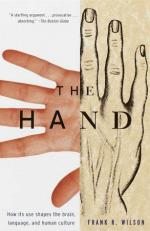
|
| Name: _________________________ | Period: ___________________ |
This test consists of 15 multiple choice questions and 5 short answer questions.
Multiple Choice Questions
1. What is the strength of a climber's grip on a rock face?
(a) Ups to 120 pound per square inch.
(b) Up to 50 pounds per square inch.
(c) Up to 80 pounds per square inch.
(d) There is no way to calculate that figure.
2. Until recently, how have anthropologists perceived ape and human hands?
(a) As functionally equivalent.
(b) As structurally equivalent.
(c) As functionally very different.
(d) As structurally radically different.
3. What is the hand considered in the metaphor in number 26?
(a) The bucket.
(b) The balance beam.
(c) The block.
(d) The beak.
4. What does the hand "think" about as it helps you get ready for the day?
(a) Nothing.
(b) How to grasp something without dropping it.
(c) How to movie each tendon and ligament for each task.
(d) How to move each muscle fgr each task.
5. What does Merlin Donald's theory of cultural and cognitive evolution propose?
(a) The human brain developed in a stop-and-go process.
(b) The human brain developed in a three-stage process.
(c) The groupings of tribes developed in a two-stage process.
(d) The human body developed in a three-stage process.
6. How does David compensate for his lack of strength?
(a) With his mental and psychological edge.
(b) By competiting with younger wrestlers.
(c) By competiting in a lower weight group.
(d) By cheating.
7. How does the conscious dimension of action occur?
(a) With the unconscious thought first.
(b) With the movement itself.
(c) There is no conscious dimension of action.
(d) With the thought of moving.
8. What did hominids require in order to expand their range beyond the jungle?
(a) Agriculture.
(b) Opposing thumb.
(c) Walking upright.
(d) Brain evolution.
9. Who is Robin Dunbar?
(a) A professor of anthropology.
(b) A professor of archeology.
(c) A professor of genealogy.
(d) A professor of biology.
10. What does the author say is a choreographed skill?
(a) Making breakfast while on the phone and reading the newspaper.
(b) Making sure a person performs all their morning abulations.
(c) Getting the children ready for school while planning your day at the office.
(d) The way the hand performs thousands of activities.
11. According to Charles Sherrington, what is a natural progression?
(a) Using intent.
(b) Juggling with increasing number of objects.
(c) The learning of motor skills.
(d) The learning of focus.
12. What is one activity the author mentions that the hand usually does in the morning?
(a) Plays with a football.
(b) Grooms the dog.
(c) Conducts a symphony.
(d) Twisting a water faucet.
13. How long can a grip on a rock last for a climber?
(a) Twenty seconds.
(b) It is incalculable.
(c) Several minutes.
(d) Forty seconds.
14. What enables the human to weigh and relate facts to solve problems?
(a) The soul.
(b) The hands.
(c) The heart.
(d) The brain.
15. What is the purpose of the shoulder, arm and hand in being fully integrated?
(a) To function simultaneously as one.
(b) To work in tandem.
(c) To act as a fulcrum.
(d) To provide more leverage together.
Short Answer Questions
1. From what does the word neuron derive its meaning?
2. What is one thing the thumb is uniquely able to do?
3. According to Wilson, how many problem-solving strategies are there that stand out above all others?
4. What does Charles Sherrington claim about the tip of the thumb and index finger?
5. How does John Napier identify the terms "power grip" and "precision grip"?
|
This section contains 593 words (approx. 2 pages at 300 words per page) |

|




